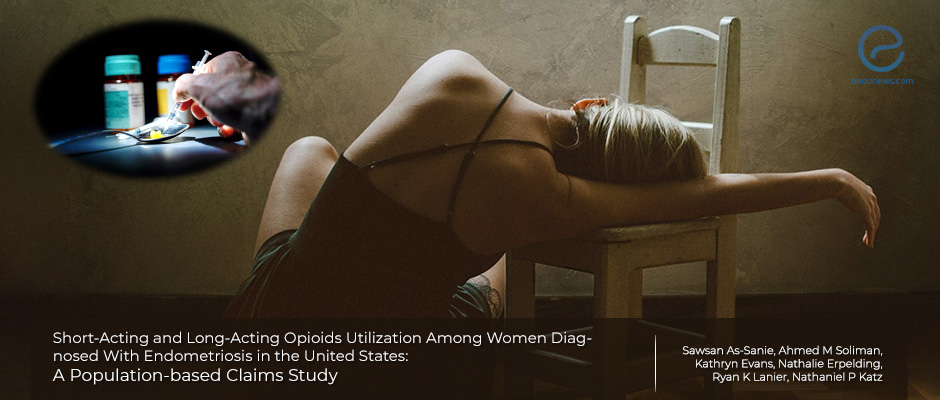Opioids use in women with endometriosis, what does it tell us?
Jun 17, 2020
Opioids are not a recommended treatment for endometriosis; however, increasing data suggest that opioid prescription is quite common within 1 year after diagnosis of endometriosis.
Key Points
Highlight:
- Opioids are not a recommended treatment for endometriosis; however, increasing data suggest that opioid prescription is quite common within 1 year after diagnosis of endometriosis.
Importance:
- Opioids use related to endometriosis may reflect a subgroup of women with higher disease burden and comorbidities who require a more careful clinical management approach.
What has been done:
- This study determines the prevalence and pattern of opioid use in women with endometriosis by analyzing medical insurance claims data.
- A retrospective cohort analysis of data from the Truven MarketScan database for the period of January 1, 2011, to December 31, 2016.
- The Truven database includes inpatient, outpatient, and prescription claims for 115 million individuals across all 50 states in the USA.
- Women with endometriosis were identified by having 1 inpatient or 2 outpatient codes for endometriosis.
- Women who filled an opioid prescription within 12 months of diagnosis were considered as using opioids for endometriosis pain.
Results:
- 58,472 women with endometriosis were identified from the database; 61.7% filled an opioid prescription.
- 95% of filled prescriptions were for short-acting opioids only, 4.1% of filled prescriptions for both short-acting and extended-release/long-acting opioids.
- 0.6% filled prescriptions for long-acting opioids only.
- The opioid prescription was associated with a higher baseline of gynecological and chronic pain comorbidities and endometriosis-related medication.
Limitation:
- A major limitation is that claims data cannot be validated without medical records as they are for healthcare billing and reimbursement purposes, not diagnostic or research. Therefore, the data can be under or over-representation of appropriate endometriosis diagnoses.
Lay Summary
Endometriosis is a debilitating disease that can cause many painful symptoms such as dysmenorrhea, dyspareunia, infertility, chronic pelvic pain, abdominal pain, and sacral or low back pain. More than half of women diagnosed with endometriosis suffer from chronic pelvic pain. With the high frequency, health, societal, and economic burden, there are still limited medications that can effectively manage pain associated with endometriosis.
Opioids are not clinically recommended for treating endometriosis pain as they have not been truly shown to be an effective treatment. However, for unmanageable pain, women with endometriosis can be prescribed with opioids. Opioids carry inherent risks of drug abuse. Considering the state of the opioid crisis in the US, it is important to characterize endometriosis patients who are using opioids and identify potential consequences.
As-Sanie and co-investigators from the Department of Obstetrics and Gynecology, University of Michigan, MI, USA investigated the characteristics of endometriosis patients who had an opioid prescription and the subsequent patterns of opioid use through a retrospective study of healthcare claims data. The study results were recently published in "The Journal of Minimally Invasive Gynecology".
The data analyzed was collected from the Truven MarketScan Commercial database for the period of January 1, 2011, to December 31, 2016. This database has inpatient, outpatient, and prescription claims from more than 115 million individuals across all the 50 states. Patients who had 1 inpatient or 2 outpatient codes for endometriosis were deemed to be diagnosed with the condition. The study looked in particular for women who filled an opioid prescription within 12 months of diagnosis which were considered as opioid users due to endometriosis. Women with endometriosis and without opioids prescription claims were considered non-users.
The results showed that there were 58,472 women with endometriosis identified from the database during this period. More than 60% filled an opioid prescription in the first year after endometriosis diagnosis. Women who made opioid prescriptions claims generally had higher comorbidities, especially those that were related to gynecological and other chronic pain, mental health disorders, and substance abuse, as compared to those who did not fill an opioid prescription. The majority of the opioid prescriptions were for short-acting opioids. In addition, opioids users were also associated with higher utilization of endometriosis-related medications compared to the non-opioid group. Therefore, women with endometriosis and filled in opioid prescriptions within the first 12 months of diagnosis may represent a subgroup of patients with greater disease burden.
Although this study is limited by claims data that have not been validated by medical records, the study findings suggest that a large proportion of endometriosis patients filled an opioid prescription within 1 year after diagnosis. Women with endometriosis who utilize opioids may experience more disease burden and comorbidities, thus needing a more careful clinical management approach. These women may also be at higher risk for opioid-related problems. Future research into the benefit outweighing the risk of opioids prescription in women with endometriosis is imperative.
Research Source: https://pubmed.ncbi.nlm.nih.gov/32531340/
pain drugs opium endometriosis advanced stage chronic disease substance abuse mental health

